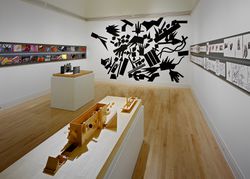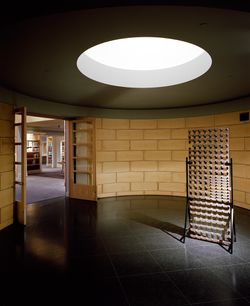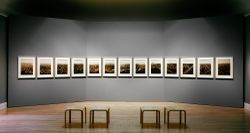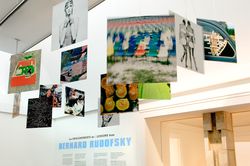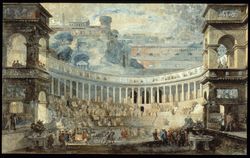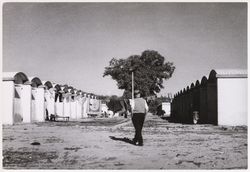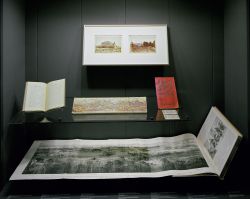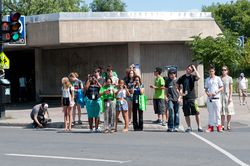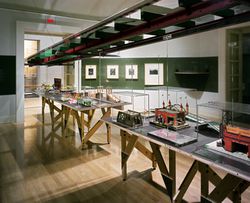During the Second World War, exhibitions and publications played a critical role in the war effort. They were organized internationally as moments of reflection and propaganda, productions of a disciplinary approach to architecture and urban design. This display springs from Jean-Louis Cohen’s research for Architecture in Uniform: Designing and Building for the Second(...)
Hall cases
13 April 2011 to 18 September 2011
A Paper War: Pictures and words, 1939-1945
Actions:
Description:
During the Second World War, exhibitions and publications played a critical role in the war effort. They were organized internationally as moments of reflection and propaganda, productions of a disciplinary approach to architecture and urban design. This display springs from Jean-Louis Cohen’s research for Architecture in Uniform: Designing and Building for the Second(...)
Hall cases
Other Soundings: Selected Works by John Hejduk, 1954–1997, the first major retrospective of Hejduk’s work, explores the themes that have always preoccupied him: architecture as a social act, the wall, the house, the church, passage and transformation, the experience of the city. The importance of John Hejduk rests on his teaching and on the originality of his vision of(...)
Main galleries
22 October 1997 to 15 February 1998
Other Soundings: Selected Works by John Hejduk, 1954-1997
Actions:
Description:
Other Soundings: Selected Works by John Hejduk, 1954–1997, the first major retrospective of Hejduk’s work, explores the themes that have always preoccupied him: architecture as a social act, the wall, the house, the church, passage and transformation, the experience of the city. The importance of John Hejduk rests on his teaching and on the originality of his vision of(...)
Main galleries
The Idea of the Penitentiary
This exhibition explores the notion of penitentiary, which worked its way into the consciousness and across the landscape of Europe and North America during the nineteenth century. Drawing upon the growing rationalist tendencies in architecture and social theory during the eighteenth century, proponents of penitentiary emphasised a clear geometry of separation,(...)
Hall cases
8 November 1995 to 31 May 1996
The Idea of the Penitentiary
Actions:
Description:
This exhibition explores the notion of penitentiary, which worked its way into the consciousness and across the landscape of Europe and North America during the nineteenth century. Drawing upon the growing rationalist tendencies in architecture and social theory during the eighteenth century, proponents of penitentiary emphasised a clear geometry of separation,(...)
Hall cases
Centring on Eadweard Muybridge’s panoramas, this exhibition examines the representations of San Francisco from 1850 to 1880, a period of phenomenal growth and development for the city. Contextualizing Muybridge’s work, the exhibition includes multi-panel daguerreotype panoramas, photographic panoramas (including sets of stereocards), photographic-view books and albums,(...)
Main galleries
31 March 1993 to 25 July 1993
Eadweard Muybridge and the Photographic Panorama of San Francisco, 1850-1880
Actions:
Description:
Centring on Eadweard Muybridge’s panoramas, this exhibition examines the representations of San Francisco from 1850 to 1880, a period of phenomenal growth and development for the city. Contextualizing Muybridge’s work, the exhibition includes multi-panel daguerreotype panoramas, photographic panoramas (including sets of stereocards), photographic-view books and albums,(...)
Main galleries
Lessons from Bernard Rudofsky is the first retrospective to examine the life and work of the controversial architect, designer, and critic whose groundbreaking buildings, exhibitions, and fashion designs challenged the Western world’s perceptions of comfort and culture. The exhibition highlights the diverse contributions of a unique and underappreciated pioneer of(...)
Main galleries
4 July 2007 to 30 September 2007
Lessons from Bernard Rudofsky
Actions:
Description:
Lessons from Bernard Rudofsky is the first retrospective to examine the life and work of the controversial architect, designer, and critic whose groundbreaking buildings, exhibitions, and fashion designs challenged the Western world’s perceptions of comfort and culture. The exhibition highlights the diverse contributions of a unique and underappreciated pioneer of(...)
Main galleries
During the eighteenth century, Rome was both an important centre for Italian art and the focal point for the studies of most European artists; all were drawn by the city’s antique art, architecture, and statuary, as well as its Renaissance, Baroque, and eighteenth-century masterpieces. Exploring Rome: Piranesi and His Contemporaries is concerned with eighteenth-century(...)
Main galleries
18 August 1993 to 2 January 1994
Exploring Rome: Piranesi and His Contemporaries
Actions:
Description:
During the eighteenth century, Rome was both an important centre for Italian art and the focal point for the studies of most European artists; all were drawn by the city’s antique art, architecture, and statuary, as well as its Renaissance, Baroque, and eighteenth-century masterpieces. Exploring Rome: Piranesi and His Contemporaries is concerned with eighteenth-century(...)
Main galleries
2016 Visiting Scholar Farhan Karim presents his research: In the recent development of architectural history, the involvement of Western architects in emerging postcolonial nations has been reviewed within the broader geopolitics of decolonization and global cold war. That analysis is certainly correct, as far as it goes, but what is needed historiographically is nuanced(...)
Shaughnessy House
7 July 2016, 6pm
Visiting Scholar Seminar: Farhan Karim
Actions:
Description:
2016 Visiting Scholar Farhan Karim presents his research: In the recent development of architectural history, the involvement of Western architects in emerging postcolonial nations has been reviewed within the broader geopolitics of decolonization and global cold war. That analysis is certainly correct, as far as it goes, but what is needed historiographically is nuanced(...)
Shaughnessy House
Civic Visions, World's Fairs
The dazzling energies of world’s fairs are well known —millions of visitors, encyclopaedic displays of goods and ideas, fantastic settings of pavilions and exhibition halls—but the sites that gather the exposition experience into a spatial unity are often overlooked. Civic Visions, World’s Fairs looks at the contribution of site planning to the history of international(...)
Hall cases
17 March 1993 to 1 August 1993
Civic Visions, World's Fairs
Actions:
Description:
The dazzling energies of world’s fairs are well known —millions of visitors, encyclopaedic displays of goods and ideas, fantastic settings of pavilions and exhibition halls—but the sites that gather the exposition experience into a spatial unity are often overlooked. Civic Visions, World’s Fairs looks at the contribution of site planning to the history of international(...)
Hall cases
The Unschool
What could a school be? For a week over summer 2012, students of The Unschool explored the spaces in and around schools and pushed the limits of the camera as a social instrument with guest curator Monica Nouwens. Participants compared how people live in schools and cities, and how design can encourage and limit behaviours, relationships, and activities. “Could(...)
30 July 2012 to 3 August 2012
The Unschool
Actions:
Description:
What could a school be? For a week over summer 2012, students of The Unschool explored the spaces in and around schools and pushed the limits of the camera as a social instrument with guest curator Monica Nouwens. Participants compared how people live in schools and cities, and how design can encourage and limit behaviours, relationships, and activities. “Could(...)
Toys and Transport
Every new transportation link and every change in systems of urban mobility introduces new infrastructure to the urban landscape: massive cuts enabling railway tracks to converge at a terminal or junction; wide railyards that service suburban and metropolitan transit systems; the proliferation of bridges, ramps, elevated highways, freeway cuts, parking lots, and even(...)
Octagonal gallery
15 November 2000 to 1 April 2001
Toys and Transport
Actions:
Description:
Every new transportation link and every change in systems of urban mobility introduces new infrastructure to the urban landscape: massive cuts enabling railway tracks to converge at a terminal or junction; wide railyards that service suburban and metropolitan transit systems; the proliferation of bridges, ramps, elevated highways, freeway cuts, parking lots, and even(...)
Octagonal gallery

